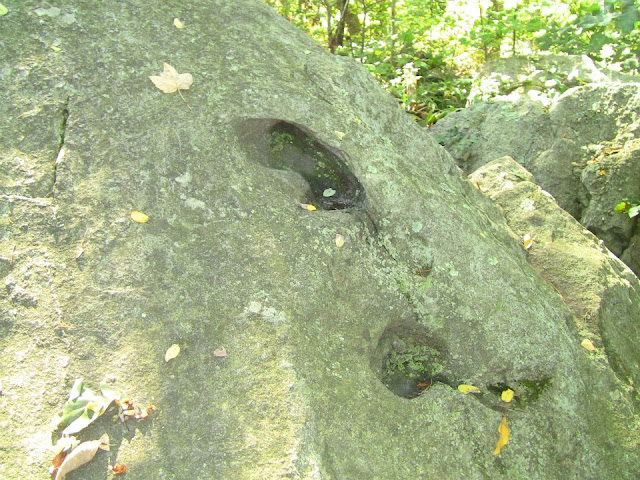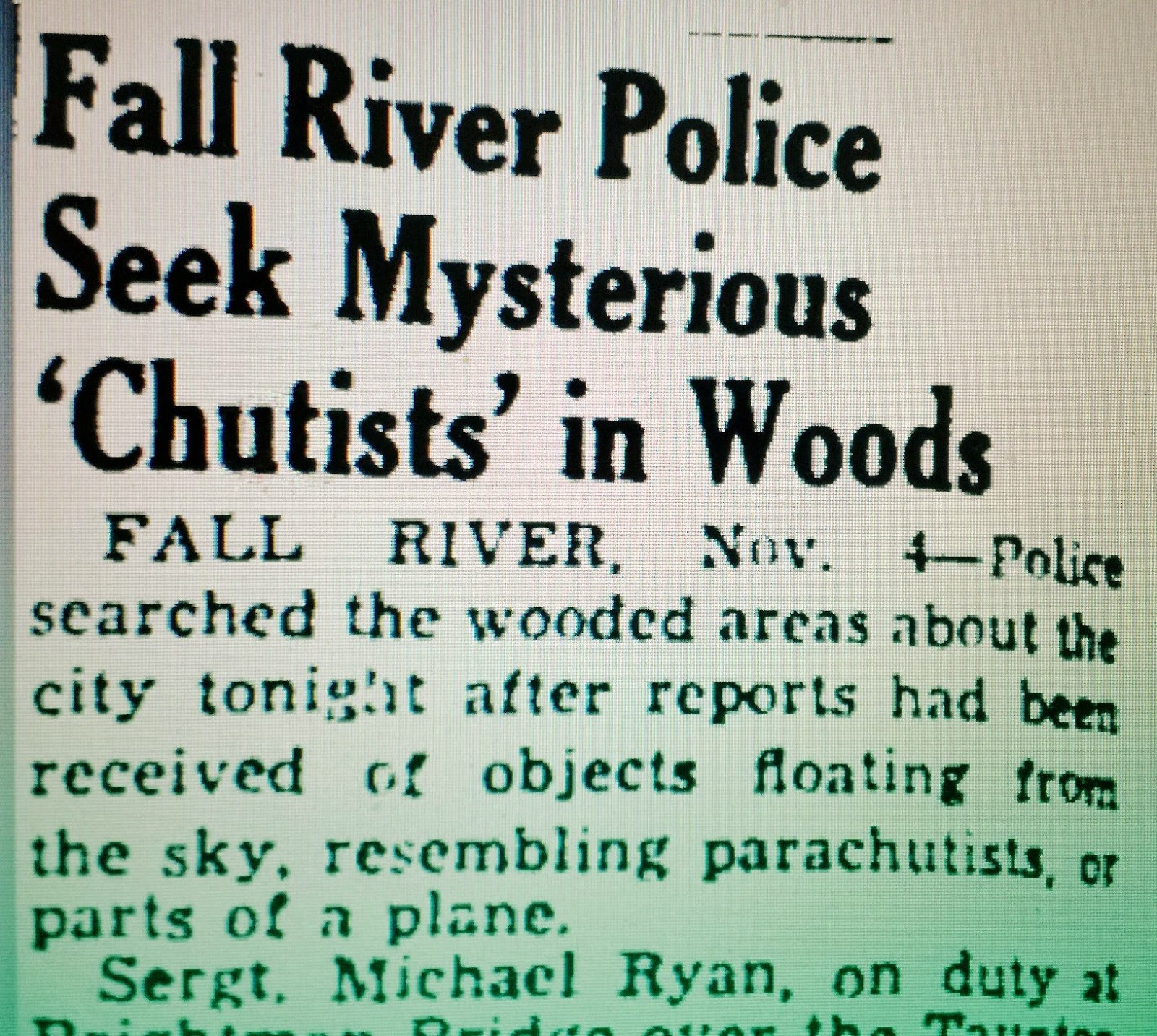The Bridgewater Triangle's Devil's Footprints
|
The Devil's Footprints can still be seen today imprinted in a large boulder in Norton, Massachusetts. Photo by Kristen Good |
Who needs the tales of Washington Irving when you have the history of the “Leonard Family of Taunton”? The Leonard family history sounds like a Washington Irving tale, with its themes of pacts with the Satan, devil's footprints, buried bones, a man on galloping on horseback through the woods carrying a severed head…even sacred Indian land. Washington Irving, most famous for spinning the legendary yarn,“The Legend of Sleepy Hollow,” wrote a short story called “The Devil and Tom Walker” in 1824. In many ways, Irving's story of a man who makes a pact with the devil, exchanging the promise of his soul in return for riches, mirrors the legend of the very real George Leonard, a wealthy ironworker who figures prominently in the history of the town of Norton.
According to the Norton Historical Society: “It is said that Leonard made a league with the devil in order to acquire great wealth. He promised his body to the devil when he died. Leonard became very rich and an influential citizen of the town. In 1716 when Leonard died, the devil came to claim his body. Surprised in the act, the devil climbed out a window. He jumped so hard on a nearby boulder, that he left footprints there. One can see those footprints on the rock by the parking lot of the Solomonese School. The mansion was situated at the corner of West Main and North Worcester Streets where Chartley Corner Plaza is today,” Says the Norton Historical society about the legend. Norton Historical Society’s George Yelle says that while he is not a believer in the paranormal, he has to admit he found it odd that when he was filmed for a local cable station special about the Devil’s Footprints at the rock he had to do the entire shoot over again. The producers of the show contacted Yelle and explained–though this had never happened before in their careers–inexplicably his interview at the Devil’s Footprints was now blank and they needed to schedule a reshoot. The second attempt at filming was successful. Washington Irving's tale of another fortune-seeking Colonial character that Irving named Tom Walker, also has a man on horseback encounter a man in black in the dark woods, but Irving places Walker in a dark swamp:
“One day that Tom Walker had been to a distant part of the neighbourhood, he took what he considered a short cut homewards through the swamp. Like most short cuts, it was an ill chosen route. The swamp was thickly grown with great gloomy pines and hemlocks, some of them ninety feet high; which made it dark at noonday, and a retreat for all the owls of the neighbourhood. In Irvings tale, Walker's destination is an old Indian Fort. “At length he arrived at a piece of firm ground, which ran out like a peninsula into the deep bosom of the swamp. It had been one of the strong holds of the Indians during their wars with the first colonists. Here they had thrown up a kind of fort which they had looked upon as almost impregnable, and had used as a place of refuge for their squaws and children.” “It was late in the dusk of evening that Tom Walker reached the old fort, and he paused there for a while to rest himself. Anyone but he would have felt unwilling to linger in this lonely melancholy place, for the common people had a bad opinion of it from the stories handed down from the time of the Indian wars; when it was asserted that the savages held incantations here and made sacrifices to the evil spirit. Tom Walker, however, was not a man to be troubled with any fears of the kind. As he turned up the soil unconsciously, his staff struck against something hard. He raked it out of the vegetable mould, and lo! a cloven skull with an Indian tomahawk buried deep in it, lay before him. It was a dreary memento of the fierce struggle that had taken place in this last foothold of the Indian warriors.”
Strange that George Leonard’s grandfather played a role in that very Indian wars Irving refers to. Because this story of the Leonard’s begins with Thomas Leonard, George Leonard’s grandfather, who was among the first men to settle the area of Taunton in the area now known as Raynham. The son of an English iron worker, Thomas Leonard and his brother immediately set out to build the first successful iron forge in the country, using the rich iron ore deposits of nearby Fowling Pond and Lake Nippenicket. Fowling Pond has long since disappeared, now a swath of land known as Pine Swamp on King Philip’s Street. Reportedly two miles long and nearly three-quarters of mile wide, historians of the 19th century recorded recollections of old timers who remembered swimming and boating on Fowling Pond in their youth.
|
|
| Fowling Pond. Image courtesy of Old Colony Historical Society. |
How Fowling Pond, once the summer camp of King Philip (Massasoit’s son) disappeared is a bit of a mystery. “Perhaps a great storm cut a swath through the embankment and drained the pond, it is one of nature’s curiosities where once King Philip rested and summered on the banks of a beautiful body of water and the tribe stocked to food to last through the long cold months ahead, there is now nothing left but the tall trees rising from a murky swamp.” Carolyn Owen, former Old Colony Historical Society Archivist. Before 1670, Thomas Leonard built a house that might have been the oldest house in country to bare the scars of war. It was said until at least the 1900s, there was “an ancient case of drawers that used to stand in this house upon which the deep scars of King Philip’s War and mangled impressions are to be seen” that was still in existence. Until its destruction in 1850, the Leonard house was officially the oldest mansion in the country The house was enormous compared to America’s standards at the time. Thomas Leonard would have no way of knowing that his grand home would serve as a garrison in a war that would go down as being the most grizzly, barbaric, and bloodiest war in the history of America. He would have no way of knowing that the house would be attacked by a band of Wampanoags. That two young girls would be savagely slain and buried beneath his prized porch. If he had the knowledge that the severed head of a man he considered a friend would lay in waiting in his cellar in that house, surely Leonard never would have built a house so grand. If he known. The sheer size of the“old gothic” Leonard house made it a perfect garrison. Known locally until its destruction as “The House of Seven Gables,” the old Leonard house rose two-and-half stories, framed with its famed facade gables. The house’s most unique feature was its impressive two story, gable-roofed porch.
 |
| The “House of Seven Gables.” Courtesy of The Old Colony Historical Society. |
The house served a major role in King Philip’s War– a war that would only last fourteen months and would totally decimate the Wampanoag Tribe, whose territories stretched from Halifax to Narragansett Bay in Rhode Island at the time of the war. “King Philip,” whose Native American name was either Pometacom or Metacom, was the second son of Chief Massasoit, who aided the pilgrims in their early years and taught them how to survive in an unfamiliar land. In 1675, after over ten years of tension between the tribe and the colonists, war broke out. Before the late 1800s, King Philip’s War was simply known as “The Indian War,” as Washington Irving refers to it in “The Devil and Tom Walker.” Massasoit’s first son Alexander (Wamsutta) was taken prisoner by the Plymouth Colony Militia in 1662 who mysteriously fell ill while being held for questioning in Duxbury. Many historians speculate, based on Plymouth Colony records, that Alexander was murdered. After Alexander’s death, Philip became chief and in the next thirteen years, tensions would only mount between the Wampanoag Tribe, who had inhabited the land for over 30,000 years and the English, who had been here roughly 40 years. There was no tension between the Leonard Family and the Wampanoag Tribe. The great chief and the Leonards were neighbors and spent time together in the summer when Philip “was in town” as well as traded amongst each other. The Leonards had valuable metal tools needed by the tribe. In 1675, inevitable war broke out. But King Philip gave strict orders to his warriors to spare Leonard Country from attacks and burning. He made them promise “never to harm a Leonard.” The Chief’s order was ignored at least twice. Once when James’ brother Uriah was shot at as he tried to escape on horseback, but fortunately for Leonard, the bullets shot at him by the Wampanoags simply passed through his hat.
The most tragic betrayal of King Philip’s men to their Chief’s command would be the shooting of two young girls who tried to flee the garrison (If it is indeed true.) In 1797, Dr. Fobes of Taunton wrote a genealogical sketch of the Leonard family. In it, this story appears for the first time. According to The Old Colony Historical Society, it seems if this happened, there would be some kind of documentation of the event, not just a blurb in a historical recollection. Fobes reported that the two girls were buried beneath the porch, (likely because the area was surrounded and people of inside the garrison, mostly woman and children, did not want to stray too far from the house to bury the two girls for fear of being shot.) Another note Fobes makes is reference to something that if it is indeed true, then was by far the most horrific act ever performed in the Old Leonard house: the “deposition” of King Philip’s head. Captured and killed on August 12, 1776, Captain Benjamin Church ordered the chief’s beheading and quartering of his body. The four corners of his body were hung in trees, Church vowing that “bones” The image of Church riding his horse, carrying around a severed head through the forests of New England on his way to present to Plymouth is gruesome indeed. That he kept the great chief’s head may have been kept at the Leonard House–King Philip’s trusted friends– is simply horrific. This writer cannot help but to wonder if James Leonard even knew, or if Church hid the head in the cellar of the garrison without consent from Leonard. Wonder is all we can do. Since no details of how long or when the head “was deposited” at the Leonard family exist on record, even the Old Colony Historical Society is forced to speculate.





